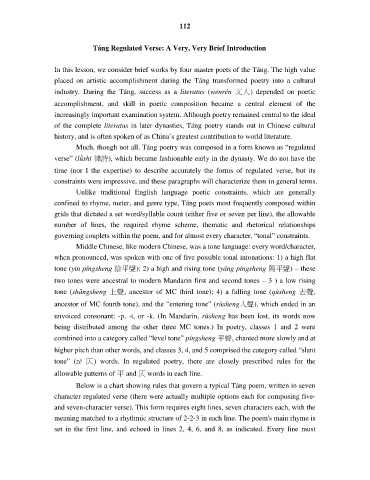Page 120 - EALC C306/505
P. 120
112
Táng Regulated Verse: A Very, Very Brief Introduction
In this lesson, we consider brief works by four master poets of the Táng. The high value
placed on artistic accomplishment during the Táng transformed poetry into a cultural
industry. During the Táng, success as a literatus (wénrén 文人) depended on poetic
accomplishment, and skill in poetic composition became a central element of the
increasingly important examination system. Although poetry remained central to the ideal
of the complete literatus in later dynasties, Táng poetry stands out in Chinese cultural
history, and is often spoken of as China’s greatest contribution to world literature.
Much, though not all, Táng poetry was composed in a form known as “regulated
verse” (lǜshi 律詩), which became fashionable early in the dynasty. We do not have the
time (nor I the expertise) to describe accurately the forms of regulated verse, but its
constraints were impressive, and these paragraphs will characterize them in general terms.
Unlike traditional English language poetic constraints, which are generally
confined to rhyme, meter, and genre type, Táng poets most frequently composed within
grids that dictated a set word/syllable count (either five or seven per line), the allowable
number of lines, the required rhyme scheme, thematic and rhetorical relationships
governing couplets within the poem, and for almost every character, “tonal” constraints.
Middle Chinese, like modern Chinese, was a tone language: every word/character,
when pronounced, was spoken with one of five possible tonal intonations: 1) a high flat
tone (yin píngsheng 陰平聲); 2) a high and rising tone (yáng píngsheng 陽平聲) – these
two tones were ancestral to modern Mandarin first and second tones – 3 ) a low rising
tone (shăngsheng 上聲, ancestor of MC third tone); 4) a falling tone (qùsheng 去聲,
ancestor of MC fourth tone), and the “entering tone” (rùsheng入聲), which ended in an
unvoiced consonant: -p, -t, or -k. (In Mandarin, rùsheng has been lost, its words now
being distributed among the other three MC tones.) In poetry, classes 1 and 2 were
combined into a category called “level tone” píngsheng 平聲, chanted more slowly and at
higher pitch than other words, and classes 3, 4, and 5 comprised the category called “slant
tone” (zè 仄) words. In regulated poetry, there are closely prescribed rules for the
allowable patterns of 平 and 仄 words in each line.
Below is a chart showing rules that govern a typical Táng poem, written in seven
character regulated verse (there were actually multiple options each for composing five-
and seven-character verse). This form requires eight lines, seven characters each, with the
meaning matched to a rhythmic structure of 2-2-3 in each line. The poem's main rhyme is
set in the first line, and echoed in lines 2, 4, 6, and 8, as indicated. Every line must

